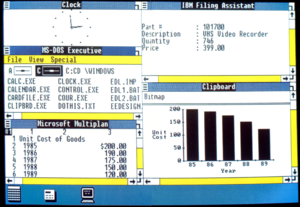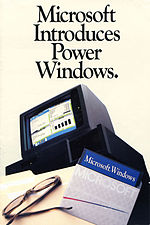Windows 1.0
| Microsoft Windows作業系統的一個版本 | |
 Windows 1.0的截圖 | |
| 開發者 | 微軟 |
|---|---|
| 作業系統家族 | Microsoft Windows |
| 原始碼模式 | 不開放原始碼 |
| 首次發布 | 1985年11月20日 |
| 目前版本 | 1.04 (1987年4月) |
| 核心類別 | MS-DOS |
| 許可證 | 專有商業軟體 |
| 後一代 | Windows 2.0(1987年) |
| 支援狀態 | |
| 2001年12月31日後停止支援 | |
Windows 1.0是Microsoft Windows的首個主要版本,但其本身並不是作業系統,而是基於MS-DOS核心的圖形應用程式環境。它於1985年11月20日在美國首次發布,而歐洲版本於1986年5月以Windows 1.02的形式發布。
Windows 1.0的開發始於1982年的電腦經銷商博覽會,微軟的聯合創始人比爾·蓋茲看到了類似軟體Visi On的演示。1983年11月,Windows 1.0首次公開亮相,並得到了一些硬體和軟體製造商的支援。但其推遲到兩年後才發行。Windows 1.0以16位元外殼程式的形式在真實模式下執行。該環境中能夠執行為Windows設計的圖形程式以及先前的MS-DOS軟體,各個程式視窗只能平鋪排列而不能堆疊排列;同時引入了多工處理,並支援滑鼠,還包括一些內建程式,如小算盤、小畫家、記事本。Windows 1.0共發布了四個版本,後續版本中主要添加了對新硬體及其他語言的支援。
Windows 1.0反響平平:批評主要聚焦於其軟體相容性和效能問題,而現代的科技媒體普遍認可它在Windows歷史上的地位。它的最後一個版本是1.04,隨後被1987年12月發布的Windows 2.0所取代。Windows 1.0於2001年12月31日終止支援,是支援時間最長的Windows版本。
開發
[編輯]
20世紀80年代左右,電腦正從字元使用者介面過渡到圖形化使用者介面。[1]1981年,微軟產生了開發基於點陣圖的圖形化使用者介面的想法。[2]1982年的電腦經銷商博覽會上,微軟的聯合創始人比爾·蓋茲看到了Visi On的演示,這是由VisiCorp開發的一套用於IBM PC相容機的圖形化使用者介面軟體套件。這啟發微軟開發自己的圖形介面。[3][4]受限於當時的電腦組態,微軟將這套圖形介面定位為具有啟動器功能的擴充模組,並著手開始開發。[1]1983年初,蘋果電腦公司發布了Apple Lisa。這款產品的圖形化使用者介面同樣基於點陣圖,並借鑑了全錄公司的研究成果,取得了長足進展;[2][5]不過其售價高昂,很多使用者望而卻步。微軟希望開發出更便宜的產品,同時也需要有獨特之處。[2][6]同年8月,比爾·蓋茲招募了斯科特·A·麥格雷戈作為新圖形介面的開發團隊負責人,他是全錄之星中視窗系統的關鍵開發人員之一。[7]:253–255[8]:157[9]在視窗系統開發前,這套圖形介面被簡單地稱為「介面管理器」(Interface Manager)。[10][11][註 1]麥格雷戈將自己先前開發的視窗系統稱為「Windows」,同時微軟行銷副總裁羅蘭·漢森也提議使用「Windows」這一名稱:該詞在軟體中頻繁出現;同時該詞在英語中很常用,因此當媒體提及該產品時,必須在前加上公司名稱「Microsoft」以避免混淆,這樣能夠提高微軟的知名度。比爾·蓋茲接受了這個意見,將該產品命名為Windows。[7]:242–245[12][13]
1983年9月,微軟首次向媒體展示了Windows原型,其使用者介面類似於Multiplan以及其他當時的微軟套用,螢幕底端有命令列;同時還能夠同時顯示多個應用程式視窗,既可以堆疊排列,也可以平鋪排列。[14]這個使用者介面概念很快被重新設計,只支援平鋪視窗,並將類似Multiplan的命令列更改為標題列下的清單欄。[15]許多觀點認為,微軟做出這一決定是為了避免與Classic Mac OS雷同。[12][16]不過根據微軟工作人員坦迪·特羅爾的說法,這可能只是早期專案經理的偏好。[16][17]重新設計後的環境在1983年11月的秋季電腦經銷商博覽會上首次公開亮相。[15]最初,微軟將這款軟體稱為MS-DOS 2.0的裝置驅動程式,需要192KB的主記憶體和兩個軟碟機。當執行「行為良好」(僅使用MS-DOS的系統呼叫)的程式時,Windows能夠同時處理多個平鋪視窗的任務;當執行「行為不良」(不使用MS-DOS的系統呼叫,而是直接操作硬體位址以控制硬體)的程式時,Windows會讓其全螢幕執行。通過這種方式,Windows能夠執行MS-DOS中的應用程式。這讓Windows從Visi On和Apple Lisa中脫穎而出。同時,與Visi On不同,Windows開發人員不需要使用Unix開發IBM PC應用程式。微軟計劃在第三方應用程式中不再強制要求使用微軟的使用者介面,以鼓勵包括競爭對手在內的其他公司開發Windows程式。[14]
一些MS-DOS電腦製造商(包括康柏、增你智、迪吉多)和軟體公司(包括阿什頓-泰特、蓮花)承諾提供對Windows的支援。[15]1983年12月,BYTE雜誌在預覽Windows後,稱其「似乎提供了非凡的開放性、可重新組態性、可移植性,以及合適的硬體要求和定價……除非其他公司推出讓人驚喜的產品,否則Windows將優先在大範圍內測試桌面比擬這一概念。」[14]Windows剛誕生時,比爾·蓋茲就將其視為微軟的未來。他在1984年4月告訴InfoWorld雜誌:「我們公司的戰略和資源完全傾向於Windows,就像我們專注於MS-DOS和Xenix之類的作業系統核心一樣。我們也強調,只有充分利用Windows的應用程式才能長期保持競爭力。」[18]但IBM並未出現在支援硬體製造商的名單中。[15]IBM最初拒絕在其銷售的裝置上預裝Windows,轉而開發自己的產品TopView。[17]微軟稱Windows與TopView不同,強調其目的不是多工處理,而是「讓電腦成為主記憶體占用較少且圖形豐富的環境」。[19]到了1984年末,Windows、TopView、數字研究公司的Graphics Environment Manager這三款視窗系統間存在競爭,有媒體稱之為「視窗之戰」(War of the Windows)。[19]麥格雷戈於1985年1月離開團隊後,史蒂夫·巴爾默接替了他的位置。[17]後來,微軟說服IBM需要圖形化使用者介面,[2]兩家公司聯合開發OS/2,並於1987年12月完成了初代版本,旨在取代MS-DOS和Windows。[20][21]
微軟曾在1983年11月承諾於1984年4月前發布Windows,[15]然而,由於各種設計修改,其發布日期推遲,[22]並因此被稱為「Vaporware」。[12]
版本發布
[編輯]- 1985年11月20日,微軟發布了首個零售版本Windows 1.01,面向美國市場銷售,售價為99美元(2023年約合280美元[23])。[16][24]
- 1986年5月,微軟發布了Windows 1.02,主要針對歐洲市場,該版本增加了對其他語言的支援。[22][25]
- 1986年8月,微軟發布了Windows 1.03,其包含了一些增強功能,包括支援非美國鍵盤[26]、添加一些監視器和印表機的驅動程式,從而取代了美國的1.01版本和歐洲的1.02版本,使得國際版本保持一致。[27]:README.txt同時,微軟也與日本電氣聯合製作了日語版,並於1986年11月發售。[1]
- 1987年4月,微軟發布了Windows 1.04,其增加了對IBM PS/2的支援。[22][28]
1987年12月9日,Windows 2.0發行。[29]:161Windows 1.0於2001年12月31日終止支援,[30]是迄今為止得到支援時間最長的Windows版本。[31]
功能
[編輯]Windows 1.0本身並不是作業系統,而是圖形應用程式環境。[16]其基於MS-DOS核心,[32]:5[33]以16位元外殼程式的形式在真實模式下執行。[34][35]Windows 1.0允許多個程式同時執行,是多工處理的早期想法。[16][36]:220各個程式視窗只能平鋪在螢幕上,不能堆疊或重疊。程式中的內容會會自動調整大小以適應可用空間。[16]程式最小化後,其圖示會出現在螢幕底部的水平線上,類似於現代的Windows工作列。[12][22]該操作環境支援滑鼠,使用者能夠使用滑鼠在螢幕上單擊。[37]與現代Windows作業系統不同,Windows 1.0中必須按住滑鼠按鈕才能顯示所選清單。[22]
Windows 1.0包含簡單的程式啟動器和檔案管理員——MS-DOS Executive,在其中打開.exe可執行檔將啟動應用程式視窗。[16]Windows 1.0也附帶了小算盤、小畫家、記事本、小作家、終端、時鐘、卡片檔案等程式。[24][38]:17系統中還包含RAMDrive(用於管理記憶卡,突破主記憶體限制)、剪貼簿、列印後台處理程式等實用程式。[24]Windows 1.0內建了《黑白棋》這一依賴於滑鼠控制的電子遊戲,旨在讓使用者學習如何移動滑鼠以及單擊螢幕元素;[39]同時,《權力平衡》可能是唯一一款在Windows 1.0上發行的商業遊戲。[16]Windows 1.0引入了控制台,能夠組態環境功能。[11]由於Windows的向下相容性,現代Windows上很有可能能夠直接執行Windows 1.0的二進制程式,並且僅需做很少修改即可將原始碼重新編譯為功能相同的「現代」應用程式。[40]
Windows 1.0還包含三個動態連結媒體櫃,分別為KERNEL.EXE、USER.EXE、GDI.EXE。[41]其中KERNEL.EXE包含了諸如任務處理、主記憶體管理、檔案輸入和輸出等功能,USER.EXE提供了使用者介面介面,GDI.EXE提供了圖形裝置介面。[42]:87[43]:66Windows 1.0 SDK中包含了這些檔案的除錯版本,可以用來替換安裝盤上的相應檔案。[44]:13,200安裝程式合併了多個系統檔案,以便加快啟動速度。使用Windows 1.0 SDK提供的除錯版本KERNEL.EXE,可以建立Windows 1.0的「慢啟動」版本,其系統檔案未經合併。[45]:README.TXTWindows 1.0可以移動主記憶體中的程式碼和資料段,以允許程式共享位於動態連結媒體櫃中的程式碼和資料;[46]同時能夠按需將程式碼從磁碟中載入,並在主記憶體不足時將其丟棄。[35]
2022年3月,有人在Windows 1.0中發現了彩蛋:一個隱藏的對話方塊,包含Windows 1.0的開發人員列表以及歡迎語「恭喜!」(Congrats!)。[47][48]
系統需求
[編輯]Windows 1.0的官方系統要求如下[1][49][50][51][52]:
| Windows 1.01 | Windows 1.02 | Windows 1.03 | Windows 1.04 | |
|---|---|---|---|---|
| 處理器 | Intel 8088 | |||
| 主記憶體 | 256 KB | 320 KB | ||
| 儲存 | 兩個雙面軟碟機或一個硬碟機 | |||
| 顯示卡 | CGA、HGC或EGA | |||
| 系統 | MS-DOS 2.0至3.30 | |||
| 滑鼠 | 建議使用相容的定點裝置,但非必需 | |||
在最低系統要求的基礎上,微軟建議在使用多個應用程式或執行DOS 3.3時增加主記憶體。[53]
反響
[編輯]Windows 1.0發布後反響平平,褒貶不一。[16][54]多數評論者認為該平台具有潛力,[54]但Cult of Mac的評論員Ed Hardy認為Windows 1.0無法與蘋果同時期的Finder 1.0競爭,[55]少數派的SUNTRISE認為Windows 1.0圖形設計粗糙,不及當時Classic Mac OS的圖示。[12]Windows 1.0也因速度慢且軟體相容性糟糕而受到批評。[56]:227也有評論批評其苛刻的系統要求,指出同時執行多個套用時效能不佳;並且使用者需要額外購買滑鼠才能充分使用作業系統。[3]《紐約時報》將配備了512KB主記憶體的電腦上執行Windows 1.0的速度比作「在北極倒糖蜜」,並且認為該操作介面的設計過於依賴滑鼠,對僅使用鍵盤的使用者不夠友好。該報總結道,Windows 1.0效能糟糕、缺乏專用軟體、與DOS程式的相容性欠佳、缺少入門教程,而Borland Sidekick之類基於DOS的軟體同樣能夠提供Windows 1.0中的功能並實現多工處理,因此後者更適合大多數電腦使用者。[53]
Computerworld雜誌報道,從1985年發布到1987年4月,Windows 1.0的銷量達到了50萬份。[57][58]現代的科技媒體普遍認為Windows 1.0是失敗的產品,但認可它在Windows歷史上的地位。[3][59][60]納撒尼爾·博倫斯坦是卓有成就的技術專家,開發了MIME標準。Windows 1.0發布後不久,他正在卡內基·梅隆大學的IT團隊中工作,微軟代表向他們首次展示Windows後,他認為相比於團隊內部的視窗管理員,「這些人帶來了可憐又幼稚的系統」,「我們當時就知道他們不會取得任何成就」。事實上他也低估了該平台的未來影響。[61]The Verge認為,Windows 8的設計理念與Windows早期版本類似,都是在保持相容性的前提下簡化操作,並且都面向新興的人體學介面裝置。Windows 1.0中提供了新的圖形化使用者介面,並面向滑鼠操作;Windows 8也提供了新型介面和軟體,並面向輕觸操作。[3]
Netflix電視劇《怪奇物語》第三季的故事背景設定在1985年,作為合作的一部分,微軟在Windows 10上開發了Windows 1.0的模擬器,並與該季同步發行。[62]
參見
[編輯]注釋
[編輯]參考資料
[編輯]- ^ 2.0 2.1 2.2 2.3 Alsop, Stewart II. Microsoft Windows: Eclectism in UI (PDF). P.C. Letter. 1988-01-18, 4 (2): 6–7 [2017-11-23]. (原始內容存檔 (PDF)於2021-03-08) (英語).
- ^ 3.0 3.1 3.2 3.3 Hollister, Sean. Revisiting Windows 1.0: how Microsoft's first desktop gracefully failed. The Verge (Vox Media). 2012-11-20 [2017-01-21]. (原始內容存檔於2019-12-01) (美國英語).
- ^ Gee, Sue. Microsoft Windows Announced 40 Years Ago. I Programmer. 2023-11-12 [2024-04-29]. (原始內容存檔於2023-12-09) (英語).
- ^ Andreadls, Kosta. You can download the source code for the iconic Apple Lisa from 1983. TweakTown. 2023-01-22 [2024-05-30]. (原始內容存檔於2024-05-30) (美國英語).
- ^ Callaham, John. A quick look back at the official announcement of Microsoft Windows 1.0 40 years ago today. Neowin. 2023-11-10 [2024-05-27]. (原始內容存檔於2024-02-06) (英語).
- ^ 7.0 7.1 Wallace, James; Erickson, Jim. Hard Drive: Bill Gates and the Making of the Microsoft Empire. New York: Harper Business. 1993-06-01. ISBN 978-0887306297. OCLC 27431749 (美國英語).
- ^ Hey, Tony; Pápay, Gyuri. The Computing Universe: A Journey Through a Revolution. New York: Cambridge University Press. 2014-12-08. ISBN 9781316123225. OCLC 899007268 (英國英語).
- ^ Caruso, Denise. An Update on Windows: Developers to get package later this month. InfoWorld. Vol. 6 no. 19 (InfoWorld Media Group, Inc.). 1984-05-07: 52. ISSN 0199-6649 (美國英語).
- ^ Hanson, Rowland. Windows is named Windows: But Why?. The HMC Company. [2019-04-07]. (原始內容存檔於2019-03-28) (英語).
- ^ 11.0 11.1 A Brief History of Microsoft Windows. Informit: 2. 2009-08-03 [2022-04-15]. (原始內容存檔於2022-03-19) (英語).
- ^ 12.0 12.1 12.2 12.3 12.4 12.5 12.6 SUNTRISE. PlatyHsu , 編. Windows 设计史(一):从青涩到成熟(Windows 1.0—95). 少數派. 2024-05-06 [2024-05-10]. (原始內容存檔於2024-05-06) (中文(中國大陸)).
- ^ Edwards, Benj. Why Is Windows Called Windows?. How-To Geek. 2022-02-07 [2024-05-10]. (原始內容存檔於2024-02-16) (英語).
- ^ 14.0 14.1 14.2 Lemmons, Phil. Microsoft Windows: A mouse with modest requirements. BYTE. Vol. 8 no. 12 (McGraw-Hill). 1983-12: 48–54. ISSN 0360-5280 (美國英語).
- ^ 15.0 15.1 15.2 15.3 15.4 Markoff, John. Microsoft Does Windows. InfoWorld (Menlo Park, CA: Popular Computing). 1983-11-21, 5 (47): 32–36. ISSN 0199-6649 (美國英語).
- ^ 16.0 16.1 16.2 16.3 16.4 16.5 16.6 16.7 16.8 Edwards, Benj. 35 Years of Microsoft Windows: Remembering Windows 1.0. How-To Geek. 2021-08-24 [2022-04-15]. (原始內容存檔於2022-02-05) (美國英語).
- ^ 17.0 17.1 17.2 Trower, Tandy. The Secret Origin of Windows. Technologizer. 2010-03-09 [2022-04-16]. (原始內容存檔於2019-09-25) (美國英語).
- ^ Caruso, Denise. Company Strategies Boomerang. InfoWorld. Vol. 6 no. 14 (InfoWorld Media Group, Inc.). 1984-04-02: 80–83. ISSN 0199-6649 (美國英語).
- ^ 19.0 19.1 Rosch, Winn L. The Curtain Rises On The War of the Windows. PC Magazine (Ziff Davis, Inc.). 1984-12-25: 33. ISSN 0888-8507 (美國英語).
- ^ McCracken, Harry. 25 Years of IBM’s OS/2: The Strange Days and Surprising Afterlife of a Legendary Operating System. Time. 2012-04-02 [2024-04-28]. (原始內容存檔於2022-11-28) (美國英語).
- ^ Farrell, Nick. NMSU shuts down ancient OS/2 archive. Fudzilla. 2024-01-30 [2024-04-28]. (原始內容存檔於2024-02-08) (英國英語).
- ^ 22.0 22.1 22.2 22.3 22.4 Hofer, Marc. Windows to the world: a brief history of this popular user interface. Media Informatics and Human-Computer Interaction Groups of the Department of Informatics of the University of Munich. 2004-12-16 [2022-04-15]. (原始內容存檔於2022-07-02) (英語).
- ^ 1634–1699: McCusker, J. J. How Much Is That in Real Money? A Historical Price Index for Use as a Deflator of Money Values in the Economy of the United States: Addenda et Corrigenda (PDF). American Antiquarian Society. 1997. 1700–1799: McCusker, J. J. How Much Is That in Real Money? A Historical Price Index for Use as a Deflator of Money Values in the Economy of the United States (PDF). American Antiquarian Society. 1992. 1800–present: Federal Reserve Bank of Minneapolis. Consumer Price Index (estimate) 1800–. [2024-02-29].
- ^ 24.0 24.1 24.2 Windows 1.0 to 10: The changing face of Microsoft's landmark OS. ZDNet. 2015-11-19 [2022-04-16]. (原始內容存檔於2022-04-16) (英語).
- ^ Vaughan-Nichols, Steven J. Should your business upgrade to Windows 11?. Computerworld. 2021-06-29 [2022-04-15]. (原始內容存檔於2022-04-08) (美國英語).
- ^ Johnsen, Niels. Microsoft Windows 1.0 frigives. go64. 2019-11-25 [2022-06-04]. (原始內容存檔於2021-01-25) (丹麥語).
- ^ Microsoft, Windows 1.03, 1986-08-24 [2024-04-29] (英語)
- ^ Petzold, Charles. OS/2: Multitasking DOS Slated for '88. PC Magazine. Vol. 6 (Ziff Davis, Inc.). 1987-05-26: 38. ISSN 0888-8507 (美國英語).
- ^ Elliott, Susan S. Across the Divide: Navigating the Digital Revolution as a Woman, Entrepreneur and CEO. Australia: Autobiographical Publishing Company. 2011. ISBN 978-1864704556. OCLC 778314925 (美國英語).
- ^ Bott, Ed. 30 years of Windows: 10 milestones that changed the face of computing. ZDNet. 2015-11-20 [2024-05-10]. (原始內容存檔於2023-02-12) (英語).
- ^ Hinks, Jamie. Windows 1.0: looking back at the OS that started it all. TechRadar. 2015-11-20 [2024-05-10]. (原始內容存檔於2024-05-25) (英語).
- ^ Shinder, Thomas W. MCSA/MCSE managing and maintaining a Windows server 2003 environment : exam 70-290 study guide and DVD training. Debra Shinder Littlejohn, Jeffrey A. Martin. Rockland, Massachusetts: Syngress. 2003. ISBN 978-0-08-047925-5. OCLC 55664320 (美國英語).
- ^ Gibbs, Samuel. From Windows 1 to Windows 10: 29 years of Windows evolution. The Guardian. 2014-10-02 [2022-04-16]. (原始內容存檔於2022-04-14) (英語).
- ^ Warren, Tom. Windows turns 35: a visual history. The Verge. 2015-11-19 [2023-02-24]. (原始內容存檔於2024-04-09) (美國英語).
- ^ 35.0 35.1 Chen, Raymond. What's up with the mysterious inc bp in function prologues of 16-bit code?. Microsoft Developer Blogs. 2011-03-16 [2022-05-05]. (原始內容存檔於2020-10-26) (英語).
- ^ O'Regan, Gerard. Introduction to the history of computing: a computing history primer. Switzerland: Springer. 2016. ISBN 978-3-319-33138-6. OCLC 953036113 (英語).
- ^ Molina, Brett. From Windows 1.0 to Windows 10: A history of Microsoft's signature PC software. Tech Xplore. 2021-06-24 [2024-05-25]. (原始內容存檔於2022-10-04) (英語).
- ^ Bangia, Ramesh; Singh, Balvir. Operating Systems and Software Diagnostics. Boston: Firewall Media. 2007. ISBN 978-8131802250 (美國英語).
- ^ PC Games Introduced with each Windows Release. Wizard IT. 2021-09-17 [2022-04-16]. (原始內容存檔於2022-06-04) (英國英語).
- ^ Getting ready for Windows 95. PC Magazine. Vol. 14 no. 9 (Ziff Davis, Inc.). 1995-05-16: 150. ISSN 0888-8507 (美國英語).
- ^ Petzold, Charles. Windows 1.0 and the Applications of Tomorrow. Charles Petzold. 2005-11-07 [2022-04-24]. (原始內容存檔於2005-11-24) (英語).
- ^ Petzold, Charles. Programming Windows 95. Charles Petzold 4. Redmond, Washington: Microsoft Press. 1996. ISBN 1-55615-676-6. OCLC 33947413 (美國英語).
- ^ McFedries, Paul. Microsoft Windows Vista Unveiled. USA: Sams Publishing. 2006. ISBN 0132715368. OCLC 70193302 (美國英語).
- ^ Microsoft Windows Software Development Kit: Programmer's Utility Guide Version 1.03. Microsoft Corporation. 1986 (英語).
- ^ Microsoft Windows Software Development Kit Version 1.03, Microsoft Corporation, 1986 (英語)
- ^ Petzold, Charles. Windows and PM: Friendly Companions or Deadly Competitors?. PC Magazine. Vol. 8 (Ziff Davis, Inc.). 1989-12-12: 330. ISSN 0888-8507 (美國英語).
- ^ Nield, David. Almost 37 years after its launch, someone found an Easter egg in Windows 1.0. TechRadar. 2022-03-19 [2022-03-21]. (原始內容存檔於2022-03-21) (英語).
- ^ Litchfield, Ted. This Windows 1.0 easter egg managed to stay hidden for nearly 37 years. PC Gamer. 2022-03-24 [2022-04-16]. (原始內容存檔於2022-04-16) (英國英語).
- ^ Windows Version History. Microsoft Support 4.0. Microsoft. 2011-09-23. (原始內容存檔於2006-11-07) (英語).
- ^ Deffree, Suzanne. Microsoft ships Windows 1.0, November 20, 1985. EDN. 2019-11-20 [2022-04-16]. (原始內容存檔於2021-10-06) (美國英語).
- ^ Fast, Faster, Fastest: Selecting and Displaying Fonts in Windows NT. PC Magazine. Vol. 13 no. 12 (Ziff Davis, Inc.). 1994-06-28: 267. ISSN 0888-8507 (美國英語).
- ^ Sullivan, Kristina B. Windows receives graphics upgrade. PC Week. Vol. 3 no. 33 (Ziff-Davis). 1986-08-19: 8. ISSN 1530-6283 (美國英語).
- ^ 53.0 53.1 Sandberg-Diment, Erik. Personal Computers; Windows Are Open At Last. The New York Times. 1986-02-25 [2013-11-11]. (原始內容存檔於2021-07-04) (美國英語).
- ^ 54.0 54.1 Langshaw, Mark. Microsoft Windows turns 30 years old today. Digital Spy. 2015-11-20 [2022-04-17]. (原始內容存檔於2022-04-17) (英國英語).
- ^ Hardy, Ed. Microsoft takes on macOS Catalina with Windows 1.0. Cult of Mac. 2019-07-03 [2024-05-25]. (原始內容存檔於2022-12-26) (美國英語).
- ^ Loguidice, Bill. Vintage game consoles: an inside look at Apple, Atari, Commodore, Nintendo, and the greatest gaming platforms of all time. Matt Barton. Burlington, MA: Focal Press. 2014. ISBN 978-1-135-00651-8. OCLC 874011835 (英語).
- ^ McCracken, Harry. A Brief History of Windows Sales Figures, 1985-Present. Time. 2013-05-07 [2022-04-17]. (原始內容存檔於2022-04-18) (美國英語).
- ^ Watt, Peggy. Few doing Windows. Computerworld. Vol. 21 no. 15 (IDG Enterprise). 1987-04-13: S4. ISSN 0010-4841 (美國英語).
- ^ Cooper, Charles. Windows 1.0: The flop that created an empire. CNET (CBS Interactive). 2013-11-20 [2014-03-18]. (原始內容存檔於2014-02-12) (美國英語).
- ^ Calore, Michael. A History of Microsoft Windows. Wired. 2008-12-10 [2022-04-17]. (原始內容存檔於2021-06-24) (美國英語).
- ^ Brodkin, Jon. Windows 1.0 turning 25: First experiences recalled. NetworkWorld. 2010-11-08 [2013-11-11]. (原始內容存檔於2010-11-10) (英語).
- ^ Warren, Tom. Microsoft's new Windows 1.11 app is a Stranger Things trip back to 1985. The Verge. 2019-07-08 [2019-07-08]. (原始內容存檔於2019-07-08) (美國英語).
外部連結
[編輯]


